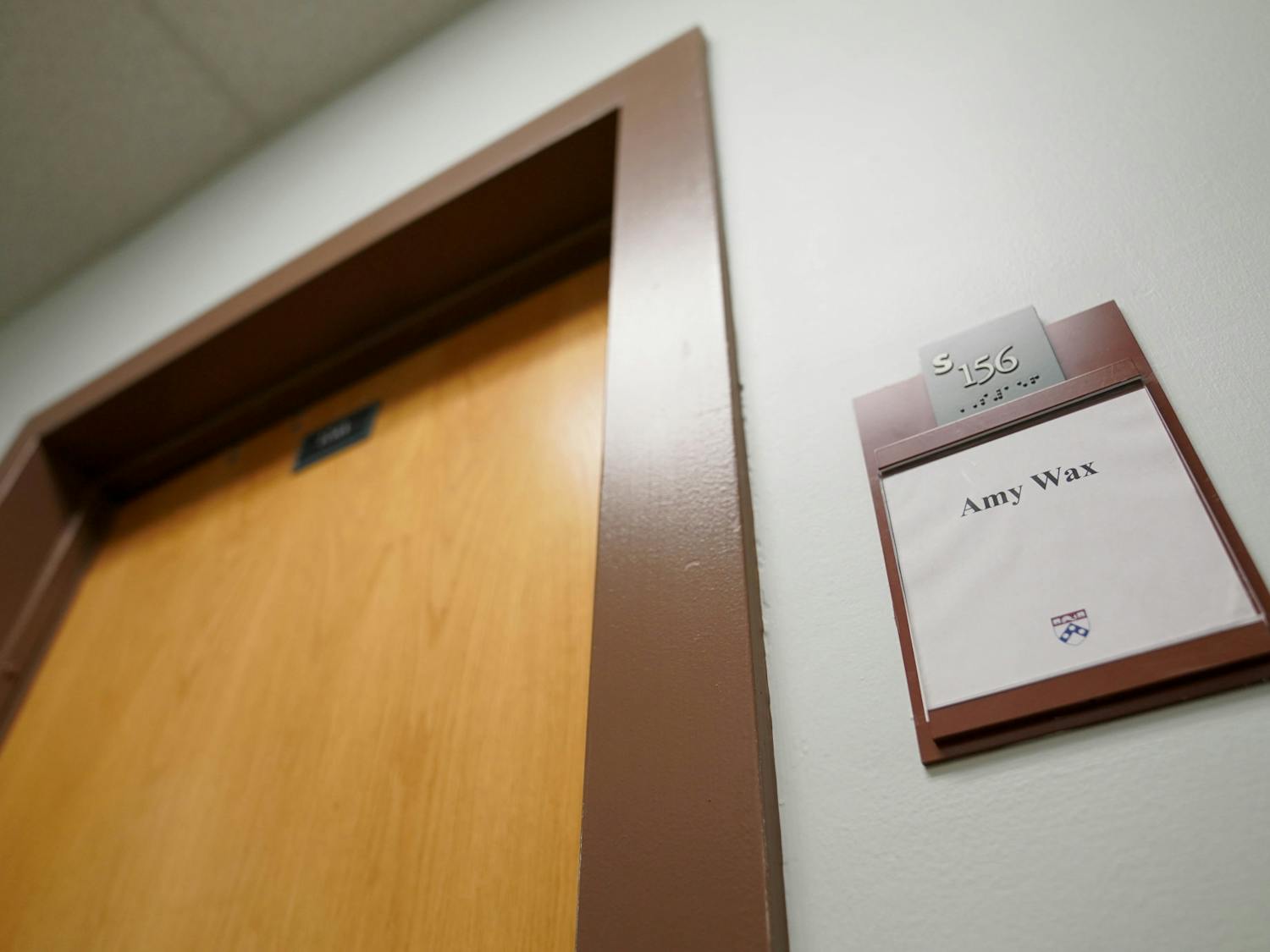Subjects at the University's Sleep and Chronobiology lab might stay awake for hours and even days as part of a study on total sleep deprivation. Some may even be expected to last an astonishing two weeks with only a few hours of sleep each night.
But it's not only the monetary compensation that motivates these subjects to live for up to two weeks beneath the dim lights of an isolation chamber, without access to the outside world, their families and a good night of sleep. They are also driven by the opportunity to be a part of the fascinating research being done by world-renowned sleep researcher David Dinges and the rest of the faculty, staff and Penn students at the lab.
'There's no lab quite like this in the world," says David Dinges, the current director of the Division of Sleep and Chronobiology lab located in the Hospital of the University of Pennsylvania. The lab has "studied more subjects than any other lab ever has," according to Dinges, and has a focus on the effects of sleep deprivation and the role of intervention like caffeine or naps on sleep cycles.
The lab conducts research with important implications for sleep-deprived students. Due to the intensity of these studies, called protocols, 50 staff members are required on site -- a combination of full-time employees and undergraduate and graduate students -- who work around the clock to monitor and test subjects. On average, 90 subjects are needed for each protocol, and generally subjects stay in the isolation chamber for about 14 days. Add it all up, and individual protocols require 1,260 days of lab work.
A recent study by Penn's lab was one of the most significant sleep studies of 2003. The study showed that losing sleep throughout the week has a cumulative effect that results in decreased performance of the brain. It combined the research of both Dinges and Hans Van Dongen, the other Penn faculty member who heads up the lab's protocols.
"You build up impairment," Dinges says, adding that it is even more disturbing that people have trouble judging how much their own abilities are hindered by sleep deprivation, so many do not realize the dire effects of sleeping a little bit less each night. Even clocking six instead of eight hours of sleep on a regular basis can be harmful.
"We've taken a lot of sleep away from people," the world-renowned researcher says proudly. The lab has deprived a remarkable 25,000 hours of sleep from subjects in the last 27 years.
Subjects range in age from 22 to 45, and must be physically and mentally fit -- all potential subjects are screened, allowing the lab to weed out excessive drinkers or anyone who might be mentally unstable. They are students and parents, those with jobs and those without, some seeking to earn a little extra cash and many who are intensely interested in the science of sleep.
Subjects are paid about $125 for every 24 hours of participation in the protocol. They are allowed to bring clothing, books and photos from home, although they are barred from making phone calls, leaving the tiny hospital rooms or interacting with anyone from the outside world.
Subjects spend their days being tested on a battery of tasks every few hours, watching movies, eating and chatting with one another until they are too tired to talk, all the while hooked up to monitors and electrodes.
The isolation chamber consists of two small rooms, containing five narrow hospital beds, which are connected to a large common room. When they do sleep, subjects are continuously monitored by video cameras.
The lab retains the grim feel of a hospital due to all of the technical equipment in the common room. Boxes of Electroencephalograph supplies stacked near the sink hold tape, gauze, wires and other materials. Rules are posted throughout the room, such as "Not Allowed: gum, caffeine, turkey, bananas" -- as bananas and turkey contain certain compounds that cause drowsiness and show up in blood tests.
The striking view from the windows is an expansive panorama of Philadelphia's skyline. The subjects, however, never see behind the blackout blinds. The curtains are always closed, and the lights are always dimmed.
*
"Most of what I do is at the boundary of biology and behavior," Dinges says, sitting in his office on the 10th floor of Blockley Hall, which is connected to the Stellar-Chance Laboratories behind the Nursing Education Building. He has light hair, a thin mustache and glasses, and is wearing a dress shirt and a striped tie. He is energetic and extremely organized, just a day after returning from Australia.
Dinges is both gifted and modest, especially considering that he is the current president of the World Federation of Sleep Research Societies, whose member societies represent 9,000 researchers from over 60 countries around the world.
Huge, laminated posters line the hallway leading to his office, like larger-than-life representations of Dinges' many years of work. The posters cite studies on such things as the effect of repeated caffeine administration on body temperature during sustained wakefulness, or changes in plasma melatonin secretion following chronic sleep restriction.
Dinges first assumed directorship of the lab in 1994, after establishing himself as a researcher and faculty member at the University. Under his direction, the lab has grown to be one of the most competitive in the world.
Dinges has the chance to observe and interact with students on a daily basis, whether they be the 30 undergraduate and graduate students who work in the lab, or the students in his classes.
"Ultimately, if I had my way, I'd like them all to get enough sleep," he says of Penn students.
One of his biggest concerns is the routine that he sees many students following, and which many universities end up promoting -- the sleep deprivation lifestyle. Dinges argues that the complications of this lifestyle could be dangerous.
"The one thing that frightens the heck out of me," he says, is the widespread tendency of students and adults to drive while sleep-deprived. "I know I'm right," he says of the devastating effects of sustained sleep deprivation on the brain's abilities. "I see the carnage."
Dinges frequently receives requests to testify as an expert at trials involving motor vehicle crashes possibly caused by sleep deprivation, so he is particularly passionate about deaths brought about by sleepy drivers. He was even involved in the infamous Exxon Valdez court case of 1989, when an oil tanker crashed in Prudhoe Bay, spilling 11 million gallons of oil onto 1,300 miles of Alaskan shoreline. The crash was determined to have been caused by a fatigued third mate and the lack of a well-rested and sufficiently numerous crew for the tanker.
Although Dinges and the lab's staff have discovered a few answers to questions about sleep, countless more remain.
"There's something mysterious about the extra hours of sleep you get," Dinges says, but the amount of time required to study a specific aspect of sleep -- gathering data for a funded research topic takes about four or five years -- means that the remaining mysteries won't be solved for quite awhile.
*
Students who want to work at the Sleep and Chronobiology lab undergo hours of training, and learn about everything from the history of research studies to rules of confidentiality. Although some of the work may seem tedious, there are still perks. Dinges allows some students who have developed ideas for protocols to venture with him to conferences around the country and present their work.
Undergraduate students work closely with the staff and full-time graduates -- who run the lab around the clock during studies -- and occasionally are assigned to supervise subjects overnight on the weekends.
Sayani Niyogi, a graduate of Harvard University, is a full-time employee at the lab, and often works the late shift. Night shifts can be tough, she says, but "you always know the subjects are having a far worse time than you are."
She notes that each subject reacts differently to losing sleep.
"I think it goes both ways. ... Once you get sleepy to a point, you just feel sleepy" no matter how much longer you stay awake, she says, although "some people are just a mess by the end," reporting symptoms like nausea and headaches.
Class of '04 College alumna Allison Stakofsky is a research lab technician like Niyogi, though she also worked at the lab as an undergraduate and conducted research toward her degree. She plans to apply to medical school after she's finished at the lab, and is grateful for the opportunity to work for Van Dongen and Dinges. She says she admires Dinges' drive and his extensive involvement with the lab.
"He really tries to take care of everyone who works for him," she says, adding that Dinges is noticeably concerned not only with what students are doing in the lab, but also what they want to do with their futures.
*
Dinges teaches classes, regularly spends 60 hours a week at the lab and travels around the world giving talks about his research, but he nevertheless stops by the lab unofficially to chat with the subjects about their experiences.
"I still come in on a Saturday or Sunday and see the subjects," he says. "Your ultimate obligation is to the subjects."
Dinges may work long hours, but he doesn't see an end in sight. The most recent set of protocols, which address questions about the role of chronic sleep restriction, will go on for another four years.
Penn's Division of Sleep and Chronobiology is certainly at the forefront of sleep research, but studies can only be conducted with adequate funding. The lab is funded entirely by an astounding amount of grant money, the sum of which Dinges declines to disclose. For the past 10 years, however, the fund has steadily grown.
Some recent studies have allowed the lab to partner with key government groups like the Department of Homeland Security, the Department of Transportation and the National Space Biomedical Research Institute.
"This is not my lab -- it's a team," Dinges says, despite the fact that he oversees nearly all of the lab's daily operations, and despite the sign near the offices that reads, "Unit for Experimental Psychology (Dinges Laboratory)."
"This only works because there's a lot of people ... deeply committed to it," he says, citing the work of employees like Research Lab Technician Olivera Crenshaw, who has over 10,000 former or potential subject contacts in her database, and Project Research Manager Michele Carlin, who deals with countless daily problems in the lab and has even been known to tape subjects' favorite shows.
Dinges says he is consistently impressed with the maturity of the undergraduate and graduate students who work in the lab. "Is it glamorous? No," he says of the work students do, but he notes that students benefit from learning technologies and working in an authentic hospital setting.
The lab has received requests to move to other universities, but Dinges loves Penn and the people who work for him.
"Once it's working, it's hard to take it apart," he says of the lab's finely tuned processes, but "the key is the people, not the technology or the space."
Even Dinges himself has spent a few days without sleep, jet-lagged or overworked. Ironically enough, many of the research assistants at the lab are the same students Dinges worries are spending too many nights studying instead of sleeping.








